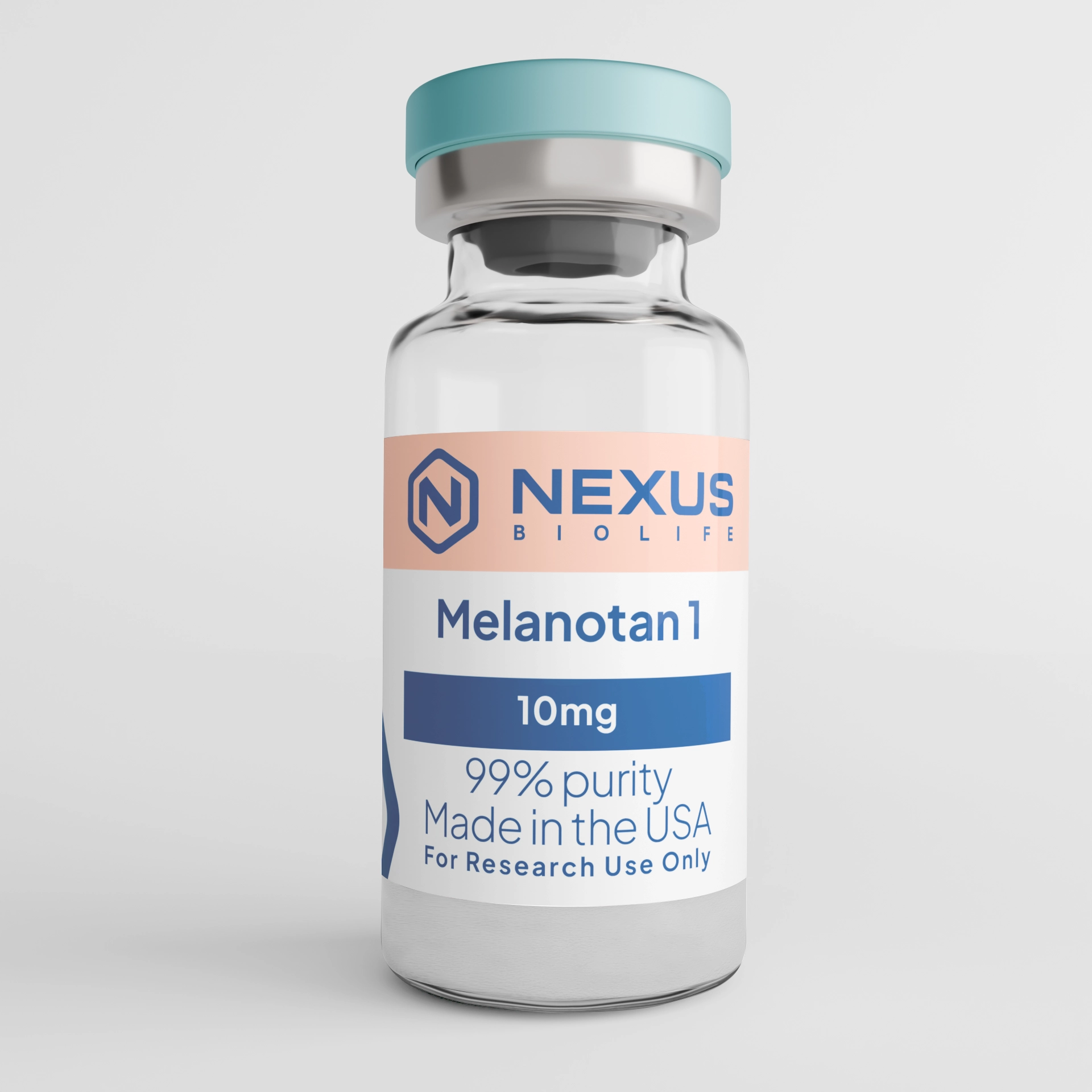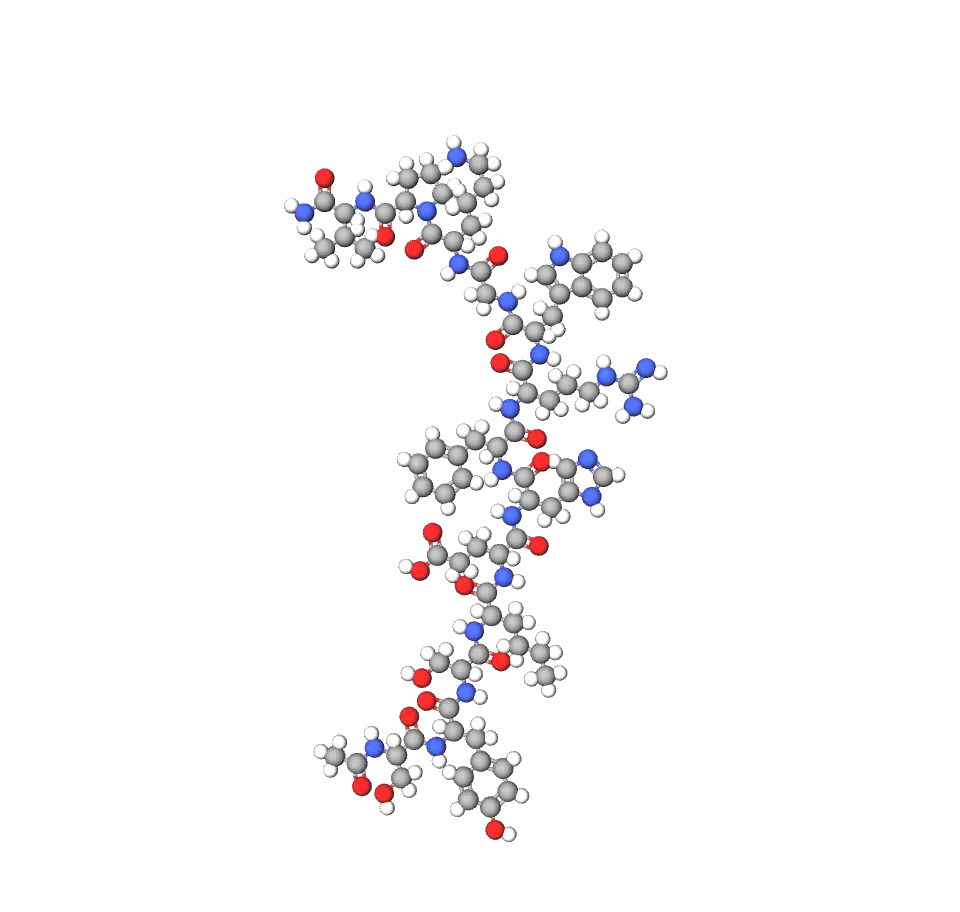
Melanotan I, or MT-1, is a synthetic peptide meticulously prepared for scientific inquiry. This product is synthesized with high purity for laboratory investigations. It is developed for use in various research applications. Melanotan I is designated solely for research and development purposes.

Melanotan I features a 13-amino-acid sequence: Ac-Ser-Tyr-Ser-Nle-Glu-His-D-Phe-Arg-Trp-Gly-Lys-Pro-Val-NH2, with key modifications including norleucine (Nle) at position 4 to prevent oxidation and D-phenylalanine (D-Phe) at position 7 to boost affinity and stability. These substitutions make it approximately 1,000 times more potent than native α-MSH, with a molecular weight of around 1,647 Da and a structure that forms additional hydrogen bonds for improved receptor interaction. The peptide's enhanced resistance to enzymatic degradation allows for sustained activity in assays, distinguishing it from shorter-lived natural counterparts.
In lab practice, Melanotan I is typically provided as a lyophilized powder with purity exceeding 98%, verified through HPLC and mass spectrometry. It exhibits good solubility in aqueous buffers at neutral pH, but its acetate salt form may influence handling in sensitive experiments. Our commitment to integrity includes rigorous testing for consistency, so you can trust it performs reliably in your setups—whether exploring binding kinetics or long-term stability.
Melanotan I, also known as afamelanotide, is a synthetic tridecapeptide analog of alpha-melanocyte-stimulating hormone (α-MSH), designed to activate melanocortin receptors and stimulate melanogenesis in experimental models. This linear peptide mimics the natural hormone's role in pigmentation while offering enhanced stability and potency, making it a useful probe for in-vitro studies on skin biology, photoprotection, and inflammatory responses. As always, our Melanotan I is supplied strictly for research purposes and in-vitro use only—not for human consumption or any therapeutic applications.
Melanotan I primarily acts as a non-selective agonist at melanocortin receptors, with high affinity for the melanocortin-1 receptor (MC1R) on melanocytes, where it elevates cyclic AMP (cAMP) levels to activate microphthalmia-associated transcription factor (MITF) and tyrosinase, key enzymes in eumelanin synthesis. This process enhances melanin production, providing photoprotective effects by absorbing UV radiation, scavenging free radicals, and supporting DNA repair pathways like nucleotide excision repair. Additionally, it exhibits anti-inflammatory properties by inhibiting NF-κB activation, reducing cytokines such as TNF-α and IL-1β, and boosting antioxidant enzymes like catalase.
In cellular models, these actions promote melanocyte proliferation and differentiation while modulating immune responses, offering a balanced profile without significant activation of other pituitary hormones. We're here to break it down simply: think of Melanotan I as a refined key that unlocks targeted pigmentation pathways, helping you rationally dissect how melanocortins influence cellular defense and homeostasis in controlled environments.
In summary, Melanotan I offers a potent and stable analog of α-MSH for probing melanocortin pathways, from eumelanin synthesis to anti-inflammatory modulation, enriching in-vitro explorations of pigmentation and photoprotection. Its refined design and multifaceted actions inspire our dedication to quality peptides that advance scientific understanding with transparency. Exclusively for research use, Melanotan I embodies our approachable expertise in fostering collaborative discoveries. Let's team up to illuminate new insights, one thoughtful study at a time.
Melanotan I's photoprotective and melanogenic properties make it a versatile tool for in-vitro research in dermatology, immunology, and photobiology. In melanocyte cultures, it has been used to study increased eumelanin content and reduced UV-induced DNA damage, such as thymine dimer formation, providing insights into skin cancer prevention models. Studies in models of erythropoietic protoporphyria (EPP) explore its ability to enhance pain-free light exposure by boosting melanin density and antioxidant defenses.
Beyond pigmentation, Melanotan I supports investigations into anti-inflammatory effects, such as in glial cell assays where it suppresses proinflammatory responses, or in renal models probing potential glomerular protection through MC1R signaling. It's also applied in vitiligo research to assess repigmentation mechanisms and in polymorphic light eruption models to evaluate reduced photosensitivity. We love empowering your work with such applications—perhaps combining it with UV exposure assays to uncover synergies—and our team is ready with logical tips to optimize your protocols for clear, reproducible results.
To ensure Melanotan I remains stable for your in-vitro experiments, store the lyophilized powder at -20°C or below in a dry, dark container to protect against moisture and light degradation. Reconstitute with sterile bacteriostatic water or a neutral buffer to concentrations of 1-2 mg/mL, gently swirling to dissolve without foaming, as vigorous mixing could disrupt the peptide's structure. Once prepared, aliquot solutions and use fresh where possible, storing at 2-8°C for short periods or freezing for longer-term needs, while avoiding repeated freeze-thaw cycles.
Our quality testing confirms its resilience, but always check for clarity and pH neutrality before assays. If you have questions about compatibility or storage variations, reach out—we'll provide evidence-based guidance to keep your research smooth and efficient.
Melanotan I, also known as afamelanotide, is a synthetic tridecapeptide analog of alpha-melanocyte-stimulating hormone (α-MSH), designed to activate melanocortin receptors and stimulate melanogenesis in experimental models. This linear peptide mimics the natural hormone's role in pigmentation while offering enhanced stability and potency, making it a useful probe for in-vitro studies on skin biology, photoprotection, and inflammatory responses. As always, our Melanotan I is supplied strictly for research purposes and in-vitro use only—not for human consumption or any therapeutic applications.
Melanotan I primarily acts as a non-selective agonist at melanocortin receptors, with high affinity for the melanocortin-1 receptor (MC1R) on melanocytes, where it elevates cyclic AMP (cAMP) levels to activate microphthalmia-associated transcription factor (MITF) and tyrosinase, key enzymes in eumelanin synthesis. This process enhances melanin production, providing photoprotective effects by absorbing UV radiation, scavenging free radicals, and supporting DNA repair pathways like nucleotide excision repair. Additionally, it exhibits anti-inflammatory properties by inhibiting NF-κB activation, reducing cytokines such as TNF-α and IL-1β, and boosting antioxidant enzymes like catalase.
In cellular models, these actions promote melanocyte proliferation and differentiation while modulating immune responses, offering a balanced profile without significant activation of other pituitary hormones. We're here to break it down simply: think of Melanotan I as a refined key that unlocks targeted pigmentation pathways, helping you rationally dissect how melanocortins influence cellular defense and homeostasis in controlled environments.
In summary, Melanotan I offers a potent and stable analog of α-MSH for probing melanocortin pathways, from eumelanin synthesis to anti-inflammatory modulation, enriching in-vitro explorations of pigmentation and photoprotection. Its refined design and multifaceted actions inspire our dedication to quality peptides that advance scientific understanding with transparency. Exclusively for research use, Melanotan I embodies our approachable expertise in fostering collaborative discoveries. Let's team up to illuminate new insights, one thoughtful study at a time.
Melanotan I features a 13-amino-acid sequence: Ac-Ser-Tyr-Ser-Nle-Glu-His-D-Phe-Arg-Trp-Gly-Lys-Pro-Val-NH2, with key modifications including norleucine (Nle) at position 4 to prevent oxidation and D-phenylalanine (D-Phe) at position 7 to boost affinity and stability. These substitutions make it approximately 1,000 times more potent than native α-MSH, with a molecular weight of around 1,647 Da and a structure that forms additional hydrogen bonds for improved receptor interaction. The peptide's enhanced resistance to enzymatic degradation allows for sustained activity in assays, distinguishing it from shorter-lived natural counterparts.
In lab practice, Melanotan I is typically provided as a lyophilized powder with purity exceeding 98%, verified through HPLC and mass spectrometry. It exhibits good solubility in aqueous buffers at neutral pH, but its acetate salt form may influence handling in sensitive experiments. Our commitment to integrity includes rigorous testing for consistency, so you can trust it performs reliably in your setups—whether exploring binding kinetics or long-term stability.

Melanotan I's photoprotective and melanogenic properties make it a versatile tool for in-vitro research in dermatology, immunology, and photobiology. In melanocyte cultures, it has been used to study increased eumelanin content and reduced UV-induced DNA damage, such as thymine dimer formation, providing insights into skin cancer prevention models. Studies in models of erythropoietic protoporphyria (EPP) explore its ability to enhance pain-free light exposure by boosting melanin density and antioxidant defenses.
Beyond pigmentation, Melanotan I supports investigations into anti-inflammatory effects, such as in glial cell assays where it suppresses proinflammatory responses, or in renal models probing potential glomerular protection through MC1R signaling. It's also applied in vitiligo research to assess repigmentation mechanisms and in polymorphic light eruption models to evaluate reduced photosensitivity. We love empowering your work with such applications—perhaps combining it with UV exposure assays to uncover synergies—and our team is ready with logical tips to optimize your protocols for clear, reproducible results.
To ensure Melanotan I remains stable for your in-vitro experiments, store the lyophilized powder at -20°C or below in a dry, dark container to protect against moisture and light degradation. Reconstitute with sterile bacteriostatic water or a neutral buffer to concentrations of 1-2 mg/mL, gently swirling to dissolve without foaming, as vigorous mixing could disrupt the peptide's structure. Once prepared, aliquot solutions and use fresh where possible, storing at 2-8°C for short periods or freezing for longer-term needs, while avoiding repeated freeze-thaw cycles.
Our quality testing confirms its resilience, but always check for clarity and pH neutrality before assays. If you have questions about compatibility or storage variations, reach out—we'll provide evidence-based guidance to keep your research smooth and efficient.
